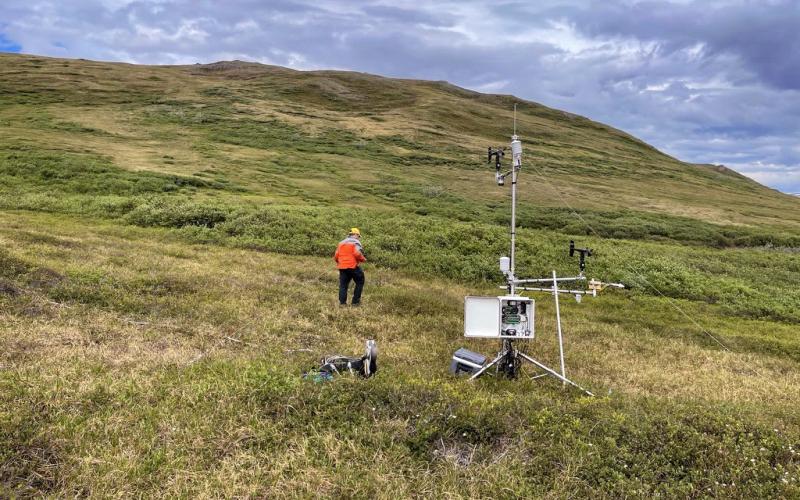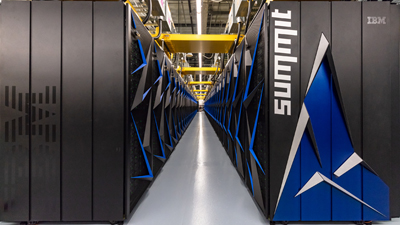 As part of the Next-Generation Ecosystem Experiments Arctic project, scientists are gathering and incorporating new data about the Alaskan tundra into global models that predict the future of our planet. Credit: ORNL/U.S. Dept. of Energy
As part of the Next-Generation Ecosystem Experiments Arctic project, scientists are gathering and incorporating new data about the Alaskan tundra into global models that predict the future of our planet. Credit: ORNL/U.S. Dept. of Energy
Improved data, models and analyses from Oak Ridge National Laboratory scientists and many other researchers in the latest global climate assessment report provide new levels of certainty about what the future holds for the planet and highlight the urgency of decarbonization to avoid the most severe impacts.
One major difference from past assessments is the unequivocal statement that human influence has warmed the atmosphere, ocean and land. This certainty is based on improved observations and modeling capabilities, according to Forrest Hoffman, lead for ORNL’s Computational Earth Sciences group and a contributing author to the report.
“Part of the certainty comes from having better observations and more observational systems, and that we’re measuring predicted changes in the real world,” Hoffman said. “Those measurements give us additional insights into the behavior of the Earth system overall. With that additional knowledge and our rapidly expanding high-performance computing capabilities, like the Summit supercomputer at ORNL, we can improve our models and their capacity to represent Earth’s past, present and future.”
Reducing uncertainty in global Earth system modeling is a primary focus for Hoffman, who leads a multi-institutional project called RUBISCO, targeting that very goal for the Biological and Environmental Research program in the Department of Energy’s Office of Science. Hoffman and his colleagues compared how closely nine of the global models underpinning the AR6 report matched observational data across many critical factors from land carbon cycling to ocean temperature and salinity gradients.
In almost all cases, the new models are significantly improved over those used for the fifth assessment report in 2013 in accurately reflecting measurements and data from the recent past. Examining how closely Earth system models simulate data from the last 150 years through the present is an important way scientists inform model development and establish confidence in future climate projections.
“The multivariate relationships are improved,” Hoffman said. “That means models are not only getting closer to the right answers for the present, but they are also doing a better job of getting those right answers for the right reasons.”
 Addressing Uncertainties
Addressing Uncertainties
These improvements are based on an extensive body of work from scientists around the world. At ORNL, the focus is on using observations from large-scale experiments and high-performance computing to translate new knowledge about underlying ecosystem processes into global models to improve Earth system predictability. The Climate Change Science Institute at ORNL advances this goal through interdisciplinary research that integrates expertise and capabilities across the laboratory. The report cites dozens of ORNL publications on topics ranging from biogeochemical cycling to plant responses to land model advancements.
The SPRUCE experiment, managed by Oak Ridge National Laboratory, provides a unique opportunity to gather and analyze data on how warming and elevated carbon dioxide levels affect carbon-rich peatlands in northern latitudes. Credit: ORNL/U.S. Dept. of Energy
Scientists are working to improve model projections by gathering and incorporating new data from ongoing research. One such area is Arctic ecosystems, which harbor vast stores of carbon in the soil and are warming twice as rapidly as the rest of the globe. Many questions remain about permafrost thaw, the warming impact of increasing vegetation growth and whether carbon unlocked from these frozen soils will be emitted as carbon dioxide or methane.
ORNL is also leading the one-of-a-kind Spruce and Peatlands Responses under Changing Environments, or SPRUCE, project to gather and analyze data from a Minnesota forested bog on how warming and elevated carbon dioxide levels affect carbon-rich peatlands in northern latitudes.
“DOE’s investment in large-scale efforts such as NGEE Artic and SPRUCE is enabling scientific discoveries with direct implications for climate change,” said Colleen Iversen, lead for the Plant-Soil Interactions group and deputy director of the NGEE Arctic project. “Large teams of scientists are measuring the pace of rapid change in the Arctic and building a range of possible climate futures within the SPRUCE experiment, all with an overarching goal of testing model predictions of what the future world might hold for our ecosystems and our society.”
Improving predictions means not only reflecting natural processes, but also the feedbacks between ecosystems, human systems and climate systems. Another area of uncertainty in AR6 is focused on these interactions in recovery scenarios, where humans are actively reducing emissions. Specifically, as humans actively cut emissions, how much will the response of natural systems influence progress toward a net-zero emissions goal?
Scientists have shown with a high degree of certainty that the land and ocean are currently absorbing part of the excess carbon dioxide in the atmosphere from human and natural sources.
There is also certainty that the net effect of removing carbon from the atmosphere will not simply be one number subtracted from another. The interaction will be far more complex, with the land and ocean likely releasing carbon into the atmosphere to bring the three systems into balance.
“On the flip side of this, when we’re trying to decrease the concentration of CO2 in the atmosphere, the ecosystems respond by putting more in,” Thornton said. “That means that the amount we think we need to remove in order to achieve a certain trajectory of CO2, we’ll have to add to that how much the land and potentially also ocean ecosystems are going to be belching back into the system. And right now, we don’t know the answer to that question.”
Further research to address these uncertainties will be key to informing policy makers in efforts to address climate change.
Turning the Corner on Carbon Emissions
“There are a lot of things we can do to turn the current trajectory around,” Hoffman said. “We have the technologies to make a difference. We should be doing whatever we can.”
Tackling the grand challenge of addressing climate change will take continued advances in understanding complex Earth systems as well as new decarbonization solutions, another major focus area at ORNL.
The laboratory has long been a leader in clean energy research, developing and deploying breakthroughs across the energy spectrum from generation to distribution to end-use. Scientists and engineers are advancing an array of solutions, from energy storage and electric vehicle technologies to green hydrogen, carbon-capture devices and biological systems that produce fuels and chemicals from renewable biomass.
“Decarbonization is a very important area of national need,” said David Sholl, director of the lab’s new Transformational Decarbonization Initiative. “It’s also an area where things need to happen rapidly and at large scale. That’s something ORNL is well positioned to do: to think about things at multiple scales at the same time, and to work across government and industry to really change the way things are done in the future.”
“We’ve shown that the emissions impacts are real,” Thornton said. “Now we have to start doing more about it.”
ORNL’s climate change research is funded by the Biological and Environmental Research program in the DOE Office of Science and uses resources at the Oak Ridge Leadership Computing Facility, a DOE Office of Science user facility.
source: ORNL



